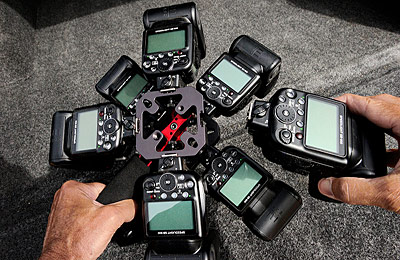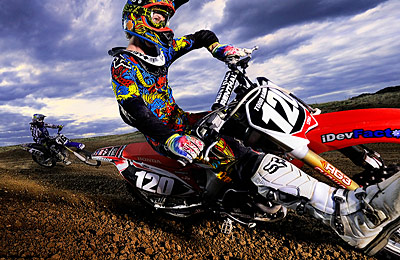Workshop at the Ranch – July 2010 – Moto Light
![]() Hi and welcome to this edition of Workshop at the Ranch. My quest to capture Sports Action with Speedlights continues in this month’s article as I light-up motocross racing. Although I have been “Speedlighting” motocross for several years the advancement in technology and new products made this day in the dust easier and more consistent than ever. With the last three Workshop at the Ranch articles being long and packed with new information, this article promises to be shorter and more concise, but no less informative. So, let’s get to it and throttle down another sport using Nikon SB-900 Speedlights, the FourSquare, Radio Poppers PX, and Michael Bass Design Fiber Optic Bundles.
Hi and welcome to this edition of Workshop at the Ranch. My quest to capture Sports Action with Speedlights continues in this month’s article as I light-up motocross racing. Although I have been “Speedlighting” motocross for several years the advancement in technology and new products made this day in the dust easier and more consistent than ever. With the last three Workshop at the Ranch articles being long and packed with new information, this article promises to be shorter and more concise, but no less informative. So, let’s get to it and throttle down another sport using Nikon SB-900 Speedlights, the FourSquare, Radio Poppers PX, and Michael Bass Design Fiber Optic Bundles.
Hi and welcome to this edition of Workshop at the Ranch. My quest to capture Sports Action with Speedlights continues in this month’s article as I light-up motocross racing. Although I have been “Speedlighting” motocross for several years the advancement in technology and new products made this day in the dust easier and more consistent than ever. With the last three Workshop at the Ranch articles being long and packed with new information, this article promises to be shorter and more concise, but no less informative. So, let’s get to it and throttle down another sport using Nikon SB-900 Speedlights, the FourSquare, Radio Poppers PX, and Michael Bass Design Fiber Optic Bundles.
If you have not read the last few monthly articles of Workshop at the Ranch let me recap what I am trying to accomplish, that being a Fill Flash. But not just any fill flash, but a Sports Action Fill Flash. The keys to success are in the technology of the more recent generations of Nikon cameras, which have very clean ultra high ISO capabilities, a custom setting of Auto FP and the dedicated Nikon SB-900 Speedlight. The combination of clean high ISO and Auto FP setting which allows me to use very fast shutter sync speeds while the Speedlights illuminate my subject whether it is an indoor sport or outdoor sport. The FourSquare block is a perfect way to hold up to 4 Speedlights. By connecting 2 FourSquares together I can create an EightSquare as I call it, which holds 8 Speedlights. The Radio Popper PX wireless system gives me the ability to fire my Speedlights from hundreds of feet off camera. The Michael Bass Design Fiber Optic Bundles completes my Speedlighting gear and makes firing with Speedlights 100% consistent even in bright sunshine. I like to use manual exposures and then purposely underexpose the general scene or ambient light by about –1.0 stop to -1.7 stop depending on how much drama I want to create. Then I reveal my subject from the underexposed scene with Speedlights from an off camera location. This technique helps me to achieve a stylized image that is more unique than the average picture.
|
|
|
|
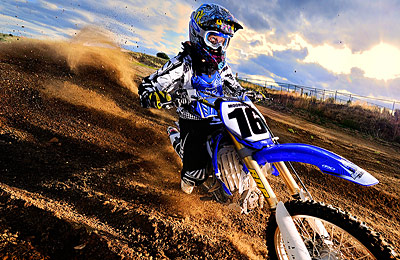 Image #3 Blue Turner … I again used a wide angle lens with this rider but chose a different corner on the race course. I slightly underexposed the sunset that is streaming in between the clouds and located my EightSquare across the track and about 35 feet in front of the subject. While the sun illuminates the dust trail behind the motorcycle my 8 Speedlights reveal the front of this athlete from a dark silhouette. Again, it is a fill flash that in this case helps reveal my subject with more light than the side/back location of the sun could provide. This image is a strong example of blending the ambient light conditions with additional fill flash for a very natural look rather than a stylized look like image#2. Nikon D3s, ISO2500, 1/2500 at f8.0, Nikon 14-24mm lens, WB 6700K, same Speedlight set-up as previously mentioned, No warming gels were used, Lexar 32G Flash Card. Image #3 Blue Turner … I again used a wide angle lens with this rider but chose a different corner on the race course. I slightly underexposed the sunset that is streaming in between the clouds and located my EightSquare across the track and about 35 feet in front of the subject. While the sun illuminates the dust trail behind the motorcycle my 8 Speedlights reveal the front of this athlete from a dark silhouette. Again, it is a fill flash that in this case helps reveal my subject with more light than the side/back location of the sun could provide. This image is a strong example of blending the ambient light conditions with additional fill flash for a very natural look rather than a stylized look like image#2. Nikon D3s, ISO2500, 1/2500 at f8.0, Nikon 14-24mm lens, WB 6700K, same Speedlight set-up as previously mentioned, No warming gels were used, Lexar 32G Flash Card. |
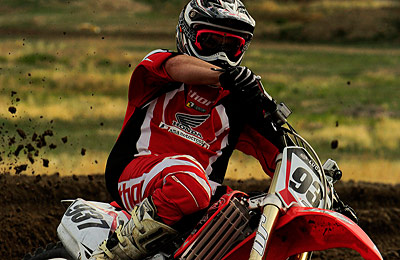 Image #4A Speedlights OFF … Here is an example of what the Speedlights are doing, or in this case not doing. I have purposely underexposed the scene by about –1.3 stop. The Speedlights are OFF and the results are a picture where I cannot see the athlete’s face. I could raise the ISO to brighten the exposure but I would then wash out the deep saturated background that the underexposure produces. My solution is to add my own light as seen in the next image and create the appearance of late day sunshine. Nikon D3s, ISO2500, 1/2500 at f8.0, New Nikon 70-200mm G VR II Zoom lens with Nikon 1.4x Teleconverter, WB 6700K, Lexar 32G Flash Card. Image #4A Speedlights OFF … Here is an example of what the Speedlights are doing, or in this case not doing. I have purposely underexposed the scene by about –1.3 stop. The Speedlights are OFF and the results are a picture where I cannot see the athlete’s face. I could raise the ISO to brighten the exposure but I would then wash out the deep saturated background that the underexposure produces. My solution is to add my own light as seen in the next image and create the appearance of late day sunshine. Nikon D3s, ISO2500, 1/2500 at f8.0, New Nikon 70-200mm G VR II Zoom lens with Nikon 1.4x Teleconverter, WB 6700K, Lexar 32G Flash Card. |
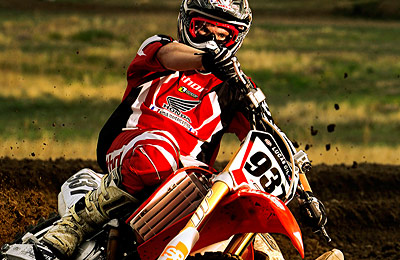 Image #4B Speedlight ON … With the Speedlight ON the difference is dramatic. I have revealed my racer with light while keeping the background slightly underexposed by –1.3 stop. It looks like a shaft of “golden hour” sunset light has spilled across the racetrack. Nikon D3s, ISO2500, 1/2500 at f8.0, New Nikon 70-200mm G VR II Zoom lens with Nikon 1.4x Teleconverter, WB 6700K, same lighting set-up but this time I placed the warming filter that comes with each Speedlight over the front of 4 of the SB-900 Speedlights. This adds a little warmth of golden light to the subject. Lexar 32G Flash Card. Image #4B Speedlight ON … With the Speedlight ON the difference is dramatic. I have revealed my racer with light while keeping the background slightly underexposed by –1.3 stop. It looks like a shaft of “golden hour” sunset light has spilled across the racetrack. Nikon D3s, ISO2500, 1/2500 at f8.0, New Nikon 70-200mm G VR II Zoom lens with Nikon 1.4x Teleconverter, WB 6700K, same lighting set-up but this time I placed the warming filter that comes with each Speedlight over the front of 4 of the SB-900 Speedlights. This adds a little warmth of golden light to the subject. Lexar 32G Flash Card. |
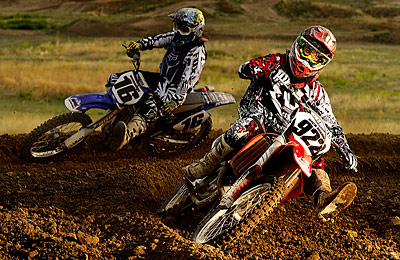 Image #5 Insider Trading … This is another example of what the Speedlights are doing. My assistant follows the lead racer through the turn with the EightSquare. I can fire a shot when I see the best moment and illuminate my athlete with a warm shaft of golden hour light from my 8 SB-900 Speedlights. The back rider is not in the shaft of light and is –1.3 stop underexposed. The viewer’s eye goes immediately to the athlete that is “lit.” The Auto FP setting allows me to use a very fast shutter sync speed of 1/2500 of a second that stops the action perfectly and still use my Speedlights. Nikon D3s, ISO2500, 1/2500 at f8.0, New Nikon 70-200mm G VR II Zoom lens, WB 6700K, same lighting set-up only this time with the warming gels on 4 of the Speedlights, Lexar 32G Flash Card. Image #5 Insider Trading … This is another example of what the Speedlights are doing. My assistant follows the lead racer through the turn with the EightSquare. I can fire a shot when I see the best moment and illuminate my athlete with a warm shaft of golden hour light from my 8 SB-900 Speedlights. The back rider is not in the shaft of light and is –1.3 stop underexposed. The viewer’s eye goes immediately to the athlete that is “lit.” The Auto FP setting allows me to use a very fast shutter sync speed of 1/2500 of a second that stops the action perfectly and still use my Speedlights. Nikon D3s, ISO2500, 1/2500 at f8.0, New Nikon 70-200mm G VR II Zoom lens, WB 6700K, same lighting set-up only this time with the warming gels on 4 of the Speedlights, Lexar 32G Flash Card. |
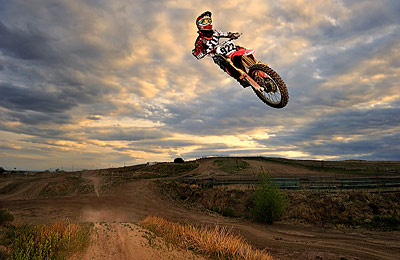 Image #6 Evening Flight … I love this picture. I made several images of each athlete as they would fly by. As a wonderful sunset sky of broken clouds formed I set my exposure to slightly underexpose the scene. Essentially this is an underexposed landscape that has a guy on a motocycle in it. He would be underexposed too and just a dark silhouette if not for my 8 SB-900 Speedlights. The –1.7 stop underexposed scene helps deepen the color saturation in the sky but still allows me to see the landscape of the racecourse. This creates a depth to the image. My EightSquare of Speedlights are high up on a 14 foot lightstand just off the track and in front of the athlete about 45 feet. The fill flash works perfectly and my athlete is revealed from silhouette. It looks as if a ray of light has illuminated him. Nikon D3s, ISO2500, 1/1600 at f8.0, Nikon 24-70mm lens, WB 6700K, same lighting set-up, no warming gels, Lexar 32G Flash Card. Image #6 Evening Flight … I love this picture. I made several images of each athlete as they would fly by. As a wonderful sunset sky of broken clouds formed I set my exposure to slightly underexpose the scene. Essentially this is an underexposed landscape that has a guy on a motocycle in it. He would be underexposed too and just a dark silhouette if not for my 8 SB-900 Speedlights. The –1.7 stop underexposed scene helps deepen the color saturation in the sky but still allows me to see the landscape of the racecourse. This creates a depth to the image. My EightSquare of Speedlights are high up on a 14 foot lightstand just off the track and in front of the athlete about 45 feet. The fill flash works perfectly and my athlete is revealed from silhouette. It looks as if a ray of light has illuminated him. Nikon D3s, ISO2500, 1/1600 at f8.0, Nikon 24-70mm lens, WB 6700K, same lighting set-up, no warming gels, Lexar 32G Flash Card. |
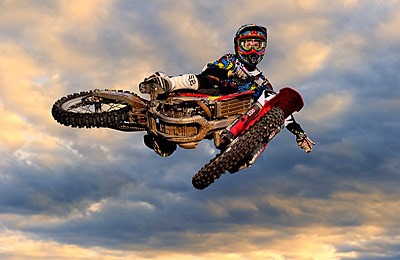 Image #7 Summer Flyer … All the same principles, technology, and data are applied in this image. The only difference is that I used the New Nikon 70-200mm G VR II Zoom lens to get closer to the action. This is how I like to photograph motocross and many other sports. Nikon D3s, ISO2500, 1/1600 at f8.0, New Nikon 70-200mm G VR II Zoom lens, same lighting set-up, Lexar 32G Flash Card. Image #7 Summer Flyer … All the same principles, technology, and data are applied in this image. The only difference is that I used the New Nikon 70-200mm G VR II Zoom lens to get closer to the action. This is how I like to photograph motocross and many other sports. Nikon D3s, ISO2500, 1/1600 at f8.0, New Nikon 70-200mm G VR II Zoom lens, same lighting set-up, Lexar 32G Flash Card. |
|
I have been photographing motocross for several years now and each time I go out to the track I challenge myself to make unique imagery. The recent generation of Nikon cameras gives me very clean ultra high ISO to work with. This clean/high ISO in turn allows me to make use of the Auto FP custom setting so I can maintain a very fast shutter sync speed that stops the sports action. With a clean ultra high ISO and fast shutter sync speed I am now able to use my SB-900 Speedlights to illuminate my subject and reveal them from an underexposed scene. This Fill Flash use of light draws instant attention to my action subject yet allows the viewer to see the environment of the sporting event. A very different approach to sports action photography and one that my clients are enjoying.
I hope you have enjoyed and learned from this article. This summer of Sports Action with Speedlights is producing some of my all time favorite pictures. In fact, I’m thinking of writing another book. I encourage you all to test your equipment’s capabilities and push yourself in an effort to make new and unique pictures.
See you next time as my summer quest for Sports Action with Speedlights continues here on Workshop at the Ranch. Adios. Dave
Here is a lot of equipment that I am using to make these Sports Action Speedlight images. I thought it might be helpful to mention where to acquire these items.
The FourSquare and all FourSquare accessories: www.lightwaredirect.com
The Lightwalker II roll-aboard case (soon to be available): www.lightwareinc.com or any camera store that carries the Lightware brand.
Radio Popper PX Transmitters and PX Receivers: www.radiopopper.com
Michael Bass Designs Fiber Optic Bundle (explained in April and May articles): www.michaelbassdesigns.com
Manfroto (formally Bogen): #155 Double Ball Joint Head and the 5/8-3/8 Rapid Adapters: available at Robert’s Imaging in Indianapolis 800-726-5544 www.robertsimaging.com
Thank you for hanging in there to the end. Hope you enjoyed the article and learned something new.


